RENAULT KOLEOS 2018 Owner's Manual
Manufacturer: RENAULT, Model Year: 2018, Model line: KOLEOS, Model: RENAULT KOLEOS 2018Pages: 332, PDF Size: 8.91 MB
Page 21 of 332
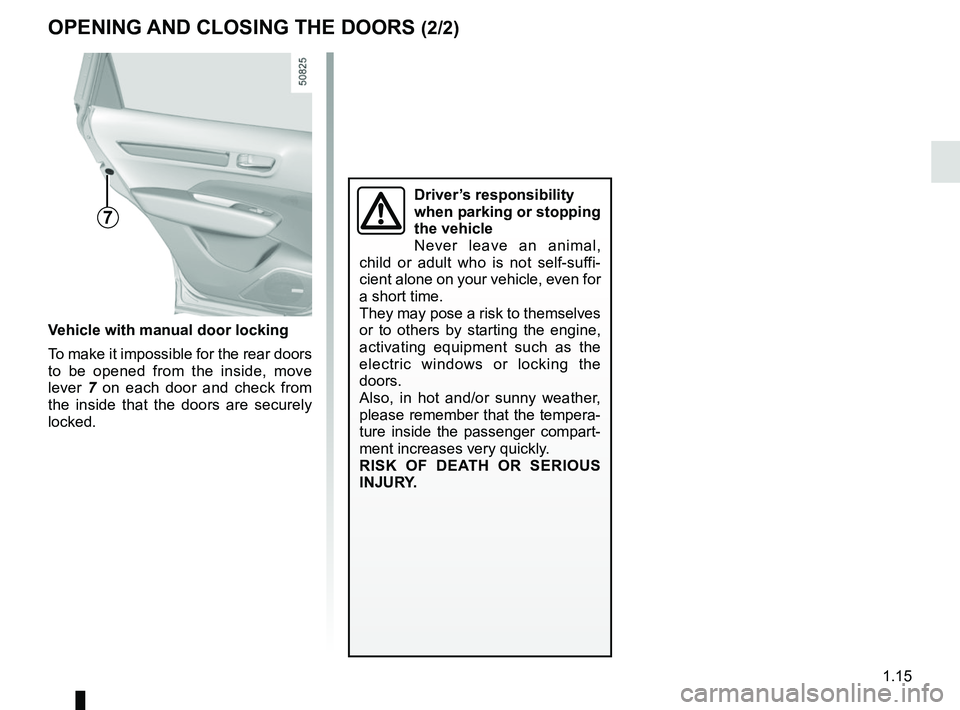
1.15
7
Vehicle with manual door locking
To make it impossible for the rear doors
to be opened from the inside, move
lever 7 on each door and check from
the inside that the doors are securely
locked.
OPENING AND CLOSING THE DOORS (2/2)
Driver’s responsibility
when parking or stopping
the vehicle
Never leave an animal,
child or adult who is not self-suffi-
cient alone on your vehicle, even for
a short time.
They may pose a risk to themselves
or to others by starting the engine,
activating equipment such as the
electric windows or locking the
doors.
Also, in hot and/or sunny weather,
please remember that the tempera-
ture inside the passenger compart-
ment increases very quickly.
RISK OF DEATH OR SERIOUS
INJURY.
Page 22 of 332

1.16
Operating faults
If you experience an operating fault (no
automatic locking, the indicator light in-
corporated in switch 1 does not light up
when trying to lock the doors and tail-
gate, etc.), make sure that locking has
not been deactivated by mistake and
check that the doors and tailgate are
properly closed. If they are correctly
locked and the fault is still present, con-
tact an authorised dealer.
Operating principle
After the vehicle is started, the system
automatically locks the doors when you
are driving at approximately 6 mph
(10 km/h) and over.
The door can be unlocked:
– by pressing the central door unlock- ing switch 1.
– at a standstill, by opening a front door from inside the vehicle.
Note: if a door is opened or closed, it
will automatically lock again when the
vehicle reaches a speed of 6 mph
(10 km/h).
AUTOMATIC LOCKING WHEN DRIVING
Driver’s responsibility
If you decide to keep the
doors locked when you are
driving, remember that it
may be more difficult for those as-
sisting you to gain access to the
passenger compartment in the
event of an emergency.
1
Activating/deactivating the
function
To switch it on: with the vehicle at a
standstill and the engine running, press
the switch 1 until a beep sounds.
To deactivate: with the vehicle at a
standstill and the engine running, press
the switch 1 until two beeps sound.
Depending on the vehicle, you can also
deactivate/activate the function from
the menu on the multifunction screen 2
(refer to the information on the “Vehicle
settings customisation menu” section 1,
“Auto door locking while driving” func-
tion).
2
Page 23 of 332

1.17
EMERGENCY CALL (1/2)
1
23
4
5
A call is always made as follows:
– the call is set up with the emergency services;
– data related to the event is sent out;
– voice communication with the emer- gency services;
– if necessary, emergency assistance is called.
Emergency call has two modes:
– automatic mode;
– manual mode;
1 Phone network availability light: on if
network available (green light), off if
network not available;
2 Automatic mode warning light;
3 SOS switch;
4 Microphone;
5 Speaker.
If the vehicle is equipped with it, the
emergency call is a system that allows
the emergency services to be called
automatically or manually in the event
of an accident or illness, in order to
reduce the time they take to arrive on
the scene.
If you use the emergency call func-
tion to report an accident which you
have witnessed, this implies stopping
where traffic conditions allow to allow
the emergency services to locate your
vehicle and therefore the location of the
reported accident.
Use emergency call only in
the event of an emergency
if you are involved in or wit-
ness an accident or if you
feel ill.In the event of an accident,
it is recommended that you
stay close to the vehicle so
that you can respond to the
call centre if necessary.
Page 24 of 332
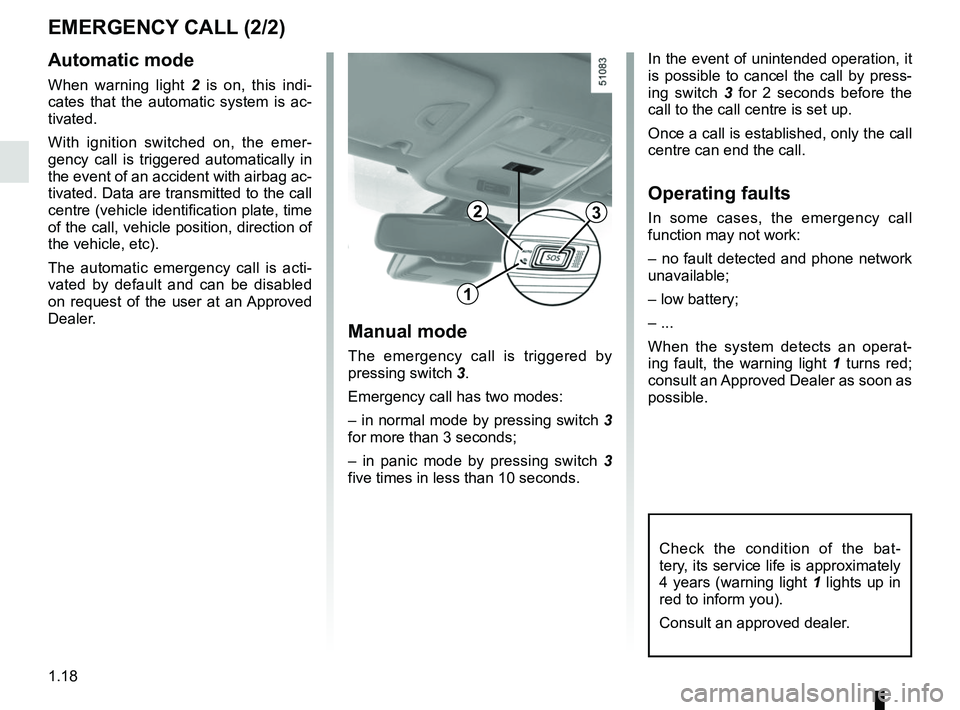
1.18
EMERGENCY CALL (2/2)
Check the condition of the bat-
tery, its service life is approximately
4 years (warning light 1 lights up in
red to inform you).
Consult an approved dealer.
23
1
Manual mode
The emergency call is triggered by
pressing switch 3.
Emergency call has two modes:
– in normal mode by pressing switch 3
for more than 3 seconds;
– in panic mode by pressing switch 3
five times in less than 10 seconds.
Automatic mode
When warning light 2 is on, this indi-
cates that the automatic system is ac-
tivated.
With ignition switched on, the emer-
gency call is triggered automatically in
the event of an accident with airbag ac-
tivated. Data are transmitted to the call
centre (vehicle identification plate, time
of the call, vehicle position, direction of
the vehicle, etc).
The automatic emergency call is acti-
vated by default and can be disabled
on request of the user at an Approved
Dealer. In the event of unintended operation, it
is possible to cancel the call by press-
ing switch 3
for 2 seconds before the
call to the call centre is set up.
Once a call is established, only the call
centre can end the call.
Operating faults
In some cases, the emergency call
function may not work:
– no fault detected and phone network
unavailable;
– low battery;
– ...
When the system detects an operat-
ing fault, the warning light 1 turns red;
consult an Approved Dealer as soon as
possible.
Page 25 of 332
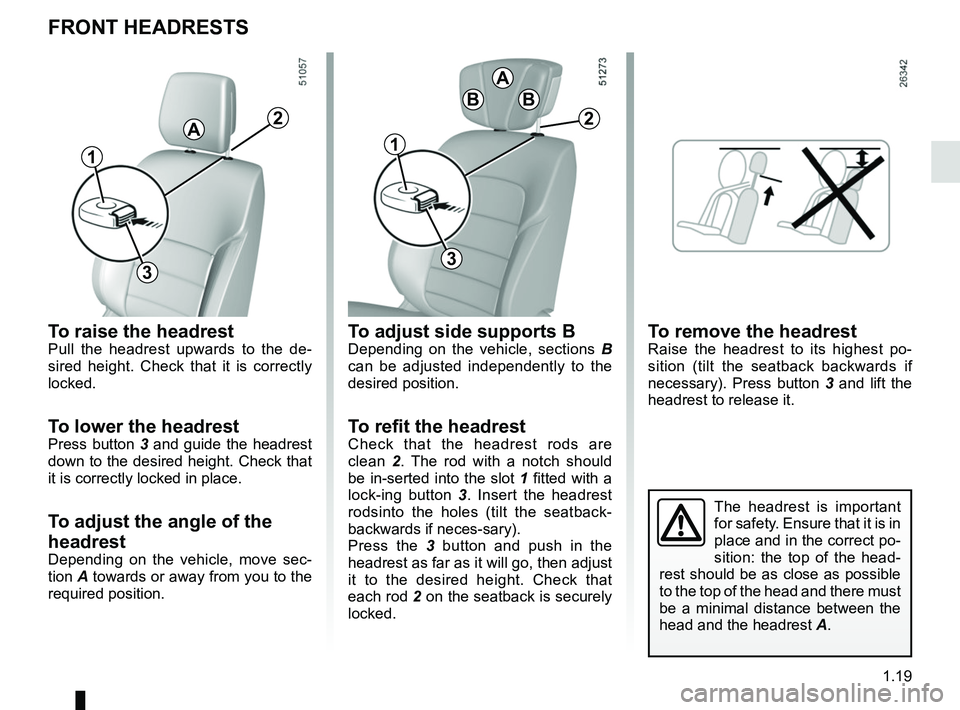
1.19
FRONT HEADRESTS
To raise the headrestPull the headrest upwards to the de-
sired height. Check that it is correctly
locked.
To lower the headrestPress button 3 and guide the headrest
down to the desired height. Check that
it is correctly locked in place.
To adjust the angle of the
headrest
Depending on the vehicle, move sec-
tion A towards or away from you to the
required position.
A
3
To adjust side supports BDepending on the vehicle, sections B
can be adjusted independently to the
desired position.
To refit the headrestCheck that the headrest rods are
clean 2. The rod with a notch should
be in-serted into the slot 1 fitted with a
lock-ing button 3 . Insert the headrest
rodsinto the holes (tilt the seatback-
backwards if neces-sary).
Press the 3 button and push in the
headrest as far as it will go, then adjust
it to the desired height. Check that
each rod 2 on the seatback is securely
locked.
The headrest is important
for safety. Ensure that it is in
place and in the correct po-
sition: the top of the head-
rest should be as close as possible
to the top of the head and there must
be a minimal distance between the
head and the headrest A.
2
11
3
2
A
BB
To remove the headrestRaise the headrest to its highest po-
sition (tilt the seatback backwards if
necessary). Press button 3 and lift the
headrest to release it.
Page 26 of 332
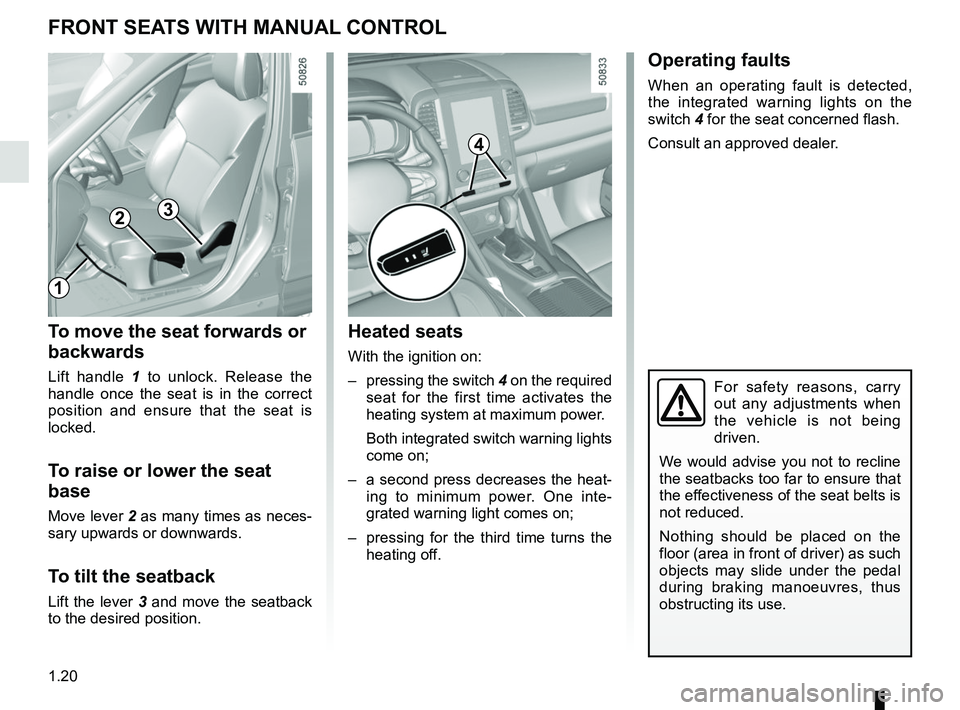
1.20
To move the seat forwards or
backwards
Lift handle 1 to unlock. Release the
handle once the seat is in the correct
position and ensure that the seat is
locked.
To raise or lower the seat
base
Move lever 2 as many times as neces-
sary upwards or downwards.
To tilt the seatback
Lift the lever 3 and move the seatback to the desired position.
FRONT SEATS WITH MANUAL CONTROL
2
1
3
For safety reasons, carry
out any adjustments when
the vehicle is not being
driven.
We would advise you not to recline
the seatbacks too far to ensure that
the effectiveness of the seat belts is
not reduced.
Nothing should be placed on the
floor (area in front of driver) as such
objects may slide under the pedal
during braking manoeuvres, thus
obstructing its use.
Heated seats
With the ignition on:
– pressing the switch 4 on the required
seat for the first time activates the
heating system at maximum power.
Both integrated switch warning lights come on;
– a second press decreases the heat- ing to minimum power. One inte-
grated warning light comes on;
– pressing for the third time turns the heating off.
4
Operating faults
When an operating fault is detected,
the integrated warning lights on the
switch 4 for the seat concerned flash.
Consult an approved dealer.
Page 27 of 332
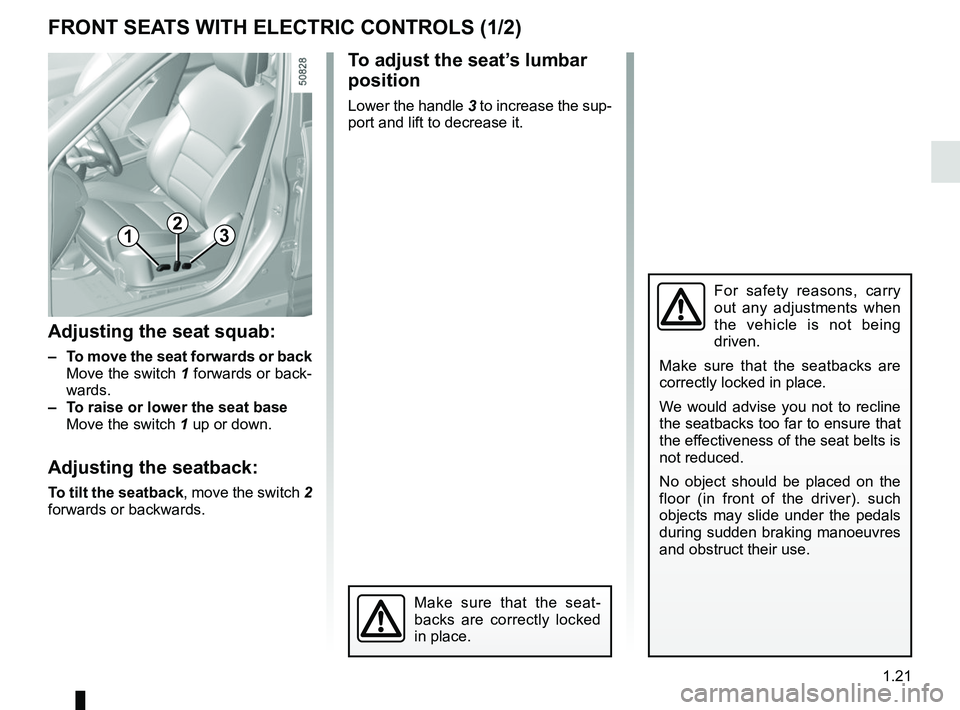
1.21
FRONT SEATS WITH ELECTRIC CONTROLS (1/2)
For safety reasons, carry
out any adjustments when
the vehicle is not being
driven.
Make sure that the seatbacks are
correctly locked in place.
We would advise you not to recline
the seatbacks too far to ensure that
the effectiveness of the seat belts is
not reduced.
No object should be placed on the
floor (in front of the driver). such
objects may slide under the pedals
during sudden braking manoeuvres
and obstruct their use.
Adjusting the seat squab:
– To move the seat forwards or back
Move the switch 1 forwards or back- wards.
– To raise or lower the seat base
Move the switch 1 up or down.
Adjusting the seatback:
To tilt the seatback, move the switch 2
forwards or backwards.
12
To adjust the seat’s lumbar
position
Lower the handle 3 to increase the sup-
port and lift to decrease it.
3
Make sure that the seat-
backs are correctly locked
in place.
Page 28 of 332
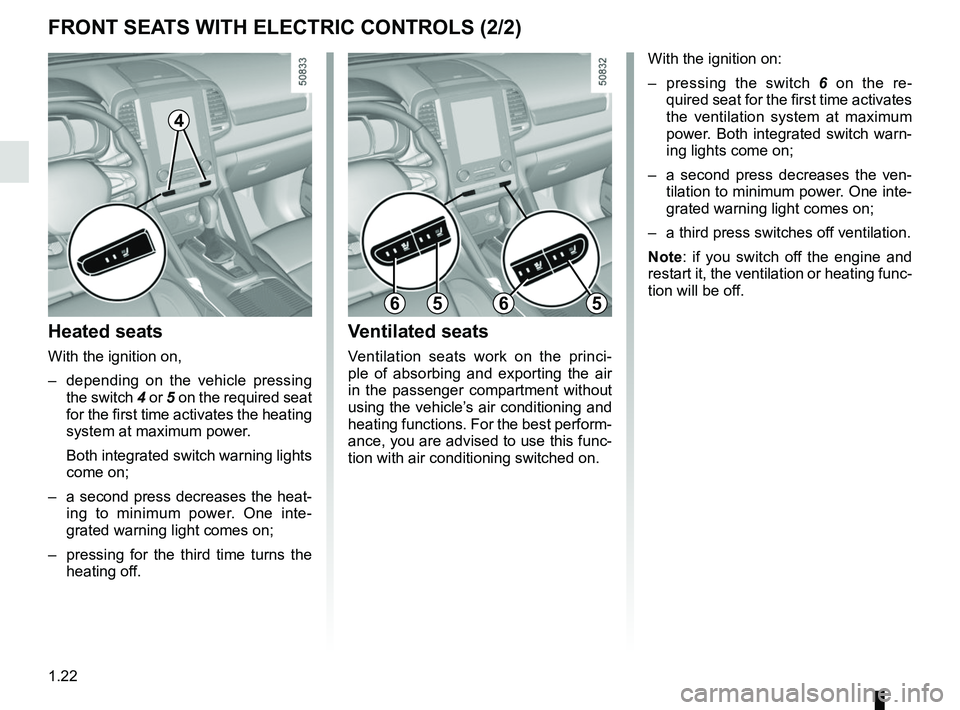
1.22
Heated seats
With the ignition on,
– depending on the vehicle pressing the switch 4 or 5 on the required seat for the first time activates the heating
system at maximum power.
Both integrated switch warning lights come on;
– a second press decreases the heat- ing to minimum power. One inte-
grated warning light comes on;
– pressing for the third time turns the heating off.
Ventilated seats
Ventilation seats work on the princi-
ple of absorbing and exporting the air
in the passenger compartment without
using the vehicle’s air conditioning and
heating functions. For the best perform-
ance, you are advised to use this func-
tion with air conditioning switched on. With the ignition on:
– pressing the switch
6 on the re-
quired seat for the first time activates
the ventilation system at maximum
power. Both integrated switch warn-
ing lights come on;
– a second press decreases the ven- tilation to minimum power. One inte-
grated warning light comes on;
– a third press switches off ventilation.
Note: if you switch off the engine and
restart it, the ventilation or heating func-
tion will be off.
FRONT SEATS WITH ELECTRIC CONTROLS (2/2)
4
6565
Page 29 of 332
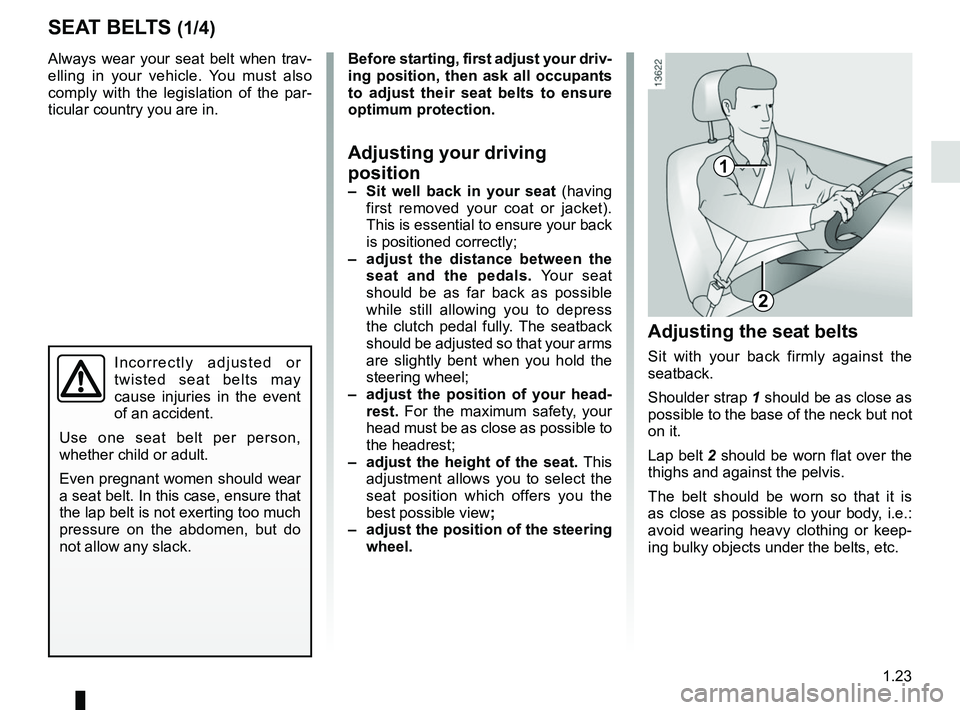
1.23
Always wear your seat belt when trav-
elling in your vehicle. You must also
comply with the legislation of the par-
ticular country you are in.
SEAT BELTS (1/4)
1
2
Incorrectly adjusted or
twisted seat belts may
cause injuries in the event
of an accident.
Use one seat belt per person,
whether child or adult.
Even pregnant women should wear
a seat belt. In this case, ensure that
the lap belt is not exerting too much
pressure on the abdomen, but do
not allow any slack.
Before starting, first adjust your driv-
ing position, then ask all occupants
to adjust their seat belts to ensure
optimum protection.
Adjusting your driving
position
– Sit well back in your seat (having
first removed your coat or jacket).
This is essential to ensure your back
is positioned correctly;
– adjust the distance between the seat and the pedals. Your seat
should be as far back as possible
while still allowing you to depress
the clutch pedal fully. The seatback
should be adjusted so that your arms
are slightly bent when you hold the
steering wheel;
– adjust the position of your head- rest. For the maximum safety, your
head must be as close as possible to
the headrest;
– adjust the height of the seat. This
adjustment allows you to select the
seat position which offers you the
best possible view ;
– adjust the position of the steering
wheel.
Adjusting the seat belts
Sit with your back firmly against the
seatback.
Shoulder strap 1 should be as close as
possible to the base of the neck but not
on it.
Lap belt 2 should be worn flat over the
thighs and against the pelvis.
The belt should be worn so that it is
as close as possible to your body, i.e.:
avoid wearing heavy clothing or keep-
ing bulky objects under the belts, etc.
Page 30 of 332
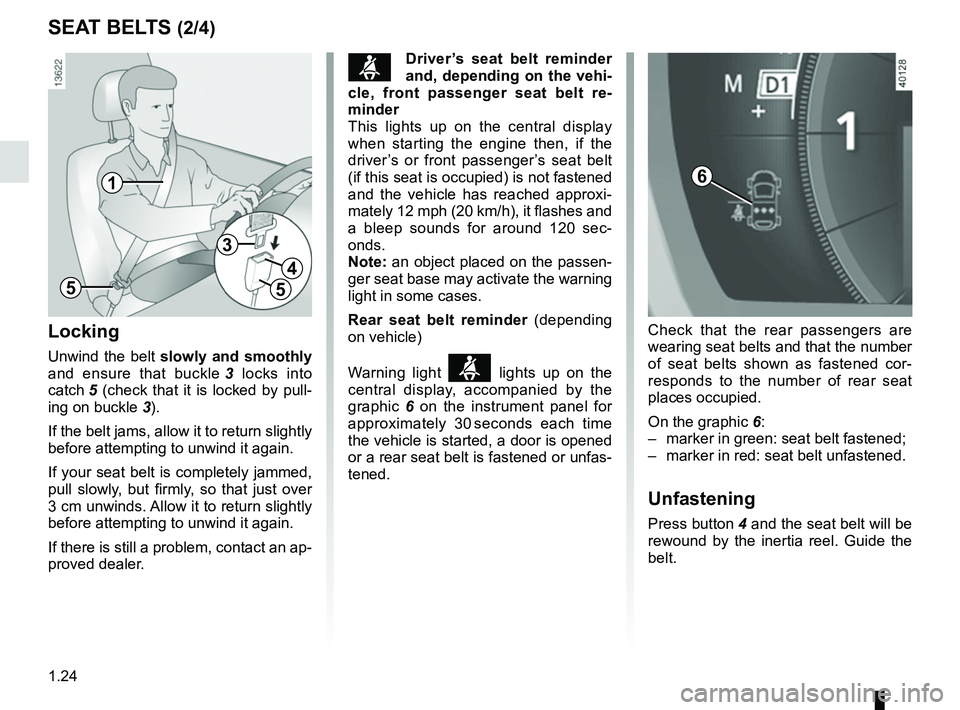
1.24
SEAT BELTS (2/4)
Locking
Unwind the belt slowly and smoothly
and ensure that buckle 3 locks into
catch 5 (check that it is locked by pull- ing on buckle 3).
If the belt jams, allow it to return slightly
before attempting to unwind it again.
If your seat belt is completely jammed,
pull slowly, but firmly, so that just over
3 cm unwinds. Allow it to return slightly
before attempting to unwind it again.
If there is still a problem, contact an ap-
proved dealer.
1
5
3
4
5
ßDriver’s seat belt reminder
and, depending on the vehi-
cle, front passenger seat belt re-
minder
This lights up on the central display
when starting the engine then, if the
driver’s or front passenger’s seat belt
(if this seat is occupied) is not fastened
and the vehicle has reached approxi-
mately 12 mph (20 km/h), it flashes and
a bleep sounds for around 120 sec-
onds.
Note: an object placed on the passen-
ger seat base may activate the warning
light in some cases.
Rear seat belt reminder (depending
on vehicle)
Warning light
ß lights up on the
central display, accompanied by the
graphic 6 on the instrument panel for
approximately 30 seconds each time
the vehicle is started, a door is opened
or a rear seat belt is fastened or unfas-
tened. Check that the rear passengers are
wearing seat belts and that the number
of seat belts shown as fastened cor-
responds to the number of rear seat
places occupied.
On the graphic 6:
– marker in green: seat belt fastened;
– marker in red: seat belt unfastened.
Unfastening
Press button 4 and the seat belt will be
rewound by the inertia reel. Guide the
belt.
6